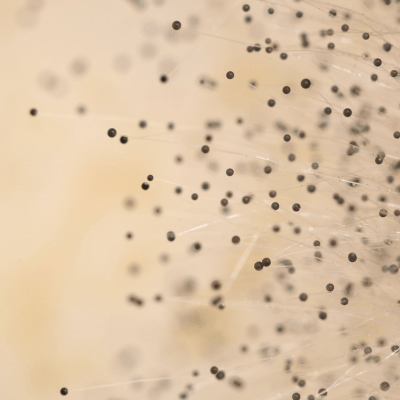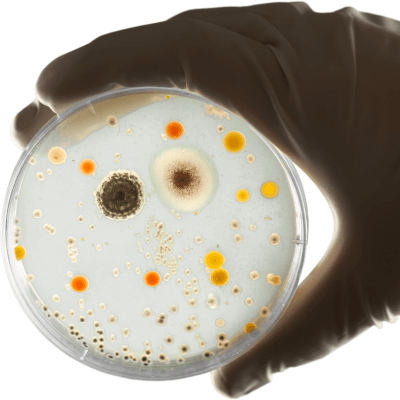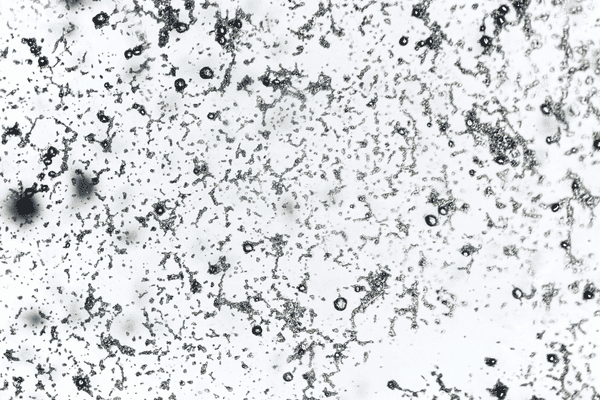Mold spores are microscopic particles that act as the seed for mold growth, silently floating in the air and waiting for the right conditions to settle and spread. If you’ve ever wondered, “What do mold spores look like?” or questioned whether your home has a hidden mold problem, you’re not alone. Mold is an issue that millions of homeowners face, yet spotting it isn’t always straightforward.
Whether you’re concerned about black mold spores causing respiratory issues or just want to improve your indoor air quality, understanding mold identification is crucial. This guide will walk you through everything you need to know, from recognizing the early signs of mold growth to scheduling a mold inspection when necessary.
What Are Mold Spores? Understanding Their Role in Mold Growth

Mold spores are tiny, airborne particles that function much like seeds. However, unlike typical plant seeds, mold spores don’t need soil to grow—just the right environmental conditions, particularly moisture, warmth, and organic material to latch onto.
Here’s a breakdown of how these microscopic invaders work:
- Invisible to the naked eye: Mold spores measure between 2 to 10 microns in diameter, making them undetectable without a microscope.
- Easily transported: They spread through the air, attach to pets and clothing, and enter homes via doors, vents, and windows.
- Moisture-dependent: Mold spores remain dormant until they land on a damp surface, where they begin multiplying.
Since spores are constantly present indoors and outdoors, the key to preventing a full-blown problem is moisture control. If you spot a small area of mold, early intervention can stop a larger infestation.
What Do Mold Spores Look Like? Identifying Visible Mold Growth

Since individual mold spores are microscopic, you won’t see them floating in the air. However, once mold colonies develop, you can visually identify them. If you’ve ever asked, “What does mold look like?” here’s what to watch for:
Typical Mold Appearances
- Fuzzy or slimy patches: Mold can appear velvety, powdery, or wet in texture, depending on the type.
- Varied colors: Common shades include black, green, white, orange, yellow, and even pink.
- Speckled or circular growth: Mold often forms small, discolored spots that expand over time.
- Musty or earthy smell: A damp, mildew-like odor is a telltale sign of hidden mold, even if you can’t see it.
Common Mold Types & Their Identifications
Before you can effectively remove a mold problem, it’s helpful to know what type you’re dealing with:
- Black Mold Spores: Typically associated with Stachybotrys chartarum, this toxic mold is often black or dark green, has a slimy texture, and thrives in areas with prolonged moisture, like drywall and carpets.
- Green Mold: Found on food, damp wood, and insulation, often associated with species like Aspergillus or Cladosporium.
- White Mold: Usually powdery in texture and found in basements, attics, and wooden structures.
- Orange/Yellow Mold: Typically found on decaying materials, such as wood or food, and is more common in humid climates.
Read more from the EPA- What Are Molds?
Hidden Mold: Signs You’re Overlooking a Serious Problem
Sometimes, mold growth isn’t visible. It can thrive behind drywall, under carpets, inside air ducts, or within the insulation. So, how do you identify mold when it’s out of sight?
Clues That Indicate Hidden Mold
- Unexplained allergies: Chronic sneezing, coughing, runny nose, or itchy skin could be a result of mold exposure.
- Persistent musty smell: A strong, damp odor in bathrooms, basements, or attics is often linked to mold growth.
- Water damage: If you’ve had recent leaks or flooding, mold spores have likely settled in those areas.
- Discolored walls or ceilings: Peeling paint, warped wood, or dark stains can indicate mold infestation.
- Increased humidity levels: If your home feels unusually damp, mold spores may already be growing.
How to Detect Mold Spores in Your Home
If you’ve noticed any warning signs but aren’t sure whether mold is present, consider these detection methods:
DIY Mold Testing Methods
While home test kits don’t guarantee accuracy, they can help establish whether mold spores are present:
- Surface tests: Swab a suspicious area and compare your results with an online mold guide.
- Air test kits: These detect airborne mold spores when left out for a specified period.
- UV Flashlights: Some molds fluoresce under UV light, making detection easier in dark areas.
Professional Mold Inspection & Testing
If you suspect mold but can’t pinpoint the source, hiring a professional for a mold inspection is the safest option. An expert can:
- Conduct air quality tests for mold spores.
- Use moisture meters to locate damp areas.
- Provide reliable mold identification.
For homeowners in Austin, Howard Environmental offers certified mold testing to identify hidden mold problems accurately.
Preventing & Removing Mold: Keeping Your Home Safe
Mold prevention starts with controlling moisture. Follow these steps to reduce the chances of an infestation:
Effective Mold Prevention Tips
- Monitor humidity levels: Keep indoor humidity below 50% using dehumidifiers.
- Improve ventilation: Use exhaust fans in bathrooms and kitchens to minimize excess moisture.
- Fix leaks immediately: Repair leaky roofs, pipes, and basements to eliminate moisture sources.
- Use mold-resistant materials: Install mold-resistant drywall and paint in moisture-prone areas.
- Regularly inspect for leaks: Checking plumbing and HVAC systems can catch moisture problems early.
Best Mold Removal Strategies
For small areas, you can remove mold using natural cleaners:
- White vinegar: Kills 82% of mold species, effective for light growth.
- Baking soda: Absorbs moisture and prevents regrowth.
- Hydrogen peroxide: Works well on porous surfaces like drywall.
For extensive mold problems, professional mold remediation is recommended.
Final Thoughts: Don’t Ignore Mold Warning Signs
Mold may be small, but its impact on your home and health can be massive. Taking a proactive approach—through early detection, moisture control, and professional inspections—can save you from costly damage and serious health issues. Ignoring mold won’t make it go away—it will only make the problem worse.
If you suspect mold in your home, don’t wait until it becomes a bigger issue.
Howard Environmental offers unbiased mold testing in Austin, ensuring homeowners get accurate results without unnecessary upselling.
Don’t wait! Protect your home by scheduling a mold inspection today.

